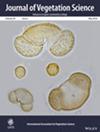Vascular Plant Traits Shape Biocrust Community Structure in a Diverse Arid Shrubland
Abstract
Question
Vascular plants and biocrusts are the main ground cover in drylands. Interaction between these components regulates a wide range of ecosystem functions. However, little is known about biocrusts associated with different vascular plant species, and understanding the interactions between them remains a challenge. We ask: Is biocrust community structure predicted by vascular plant species? Which vascular plant traits influence biocrust community structure and help to explain biocrust-plant interactions? Does the interaction between biocrusts and vascular plants vary across landforms?
Location
Arid shrubland in Patagonia, Argentina.
Methods
We measured the composition and cover of biocrusts growing in open interspaces and beneath different vascular plant species, and quantified canopy and root traits of the eight most abundant vascular plant species in two different landforms. We explored the specificity of biocrust-plant interactions by evaluating differences in biocrust structure in relation to multiple vascular plant traits.
Results
Biocrust cover was higher beneath vascular plant canopies than in open interspaces and increased with vegetation cover at the landscape scale. Different vascular plant species hosted different biocrust assemblages, which were partially explained by plant canopy architecture traits. However, relevant vascular plant traits differed in relation to biocrust composition or total cover. Whereas loose, large, and inverted cone-shaped canopies provided a canopy service for the development of biocrust cover, vascular plant height was strongly correlated to a gradient in biocrust composition from ruderal to slow-colonizer species.
Conclusions
Our study demonstrates that vascular plants greatly contribute to increasing biocrust heterogeneity, evidencing that biocrust-plant interaction should be accounted for in the assessment of dryland ecology and management. In addition, our results suggest trait-specificity of vascular plant-biocrust interactions, so that further field vascular plant trait-based studies have the potential to contribute to the search for general patterns of biocrust-plant interactions.

 求助内容:
求助内容: 应助结果提醒方式:
应助结果提醒方式:


